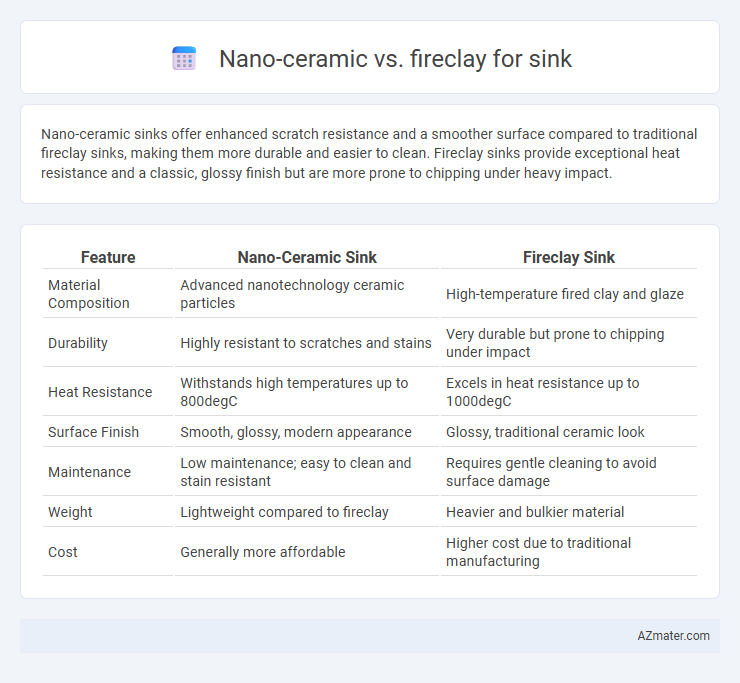Nano-ceramic sinks offer enhanced scratch resistance and a smoother surface compared to traditional fireclay sinks, making them more durable and easier to clean. Fireclay sinks provide exceptional heat resistance and a classic, glossy finish but are more prone to chipping under heavy impact.
Table of Comparison
| Feature | Nano-Ceramic Sink | Fireclay Sink |
|---|---|---|
| Material Composition | Advanced nanotechnology ceramic particles | High-temperature fired clay and glaze |
| Durability | Highly resistant to scratches and stains | Very durable but prone to chipping under impact |
| Heat Resistance | Withstands high temperatures up to 800degC | Excels in heat resistance up to 1000degC |
| Surface Finish | Smooth, glossy, modern appearance | Glossy, traditional ceramic look |
| Maintenance | Low maintenance; easy to clean and stain resistant | Requires gentle cleaning to avoid surface damage |
| Weight | Lightweight compared to fireclay | Heavier and bulkier material |
| Cost | Generally more affordable | Higher cost due to traditional manufacturing |
Introduction to Nano-ceramic and Fireclay Sinks
Nano-ceramic sinks feature advanced nanotechnology that enhances durability, scratch resistance, and stain repellency, making them highly practical for modern kitchens. Fireclay sinks are crafted from a mixture of clay and glaze, fired at extremely high temperatures to create a strong, non-porous surface that resists chips and heat. Both materials offer long-lasting performance and aesthetic appeal, but nano-ceramic emphasizes innovative material science while fireclay relies on traditional kiln-fired craftsmanship.
Material Composition and Manufacturing Process
Nano-ceramic sinks are made from advanced ceramic materials with nanoparticles that enhance durability and resistance to scratches and stains, produced through high-temperature sintering that fuses raw materials into a dense, non-porous surface. Fireclay sinks consist of clay mixed with feldspar and quartz, fired at extremely high temperatures to create a glass-like, heavy, and chip-resistant finish with slight porosity. The manufacturing process of nano-ceramic involves precise nanomaterial dispersion for superior strength, while fireclay relies on traditional kiln firing techniques to achieve its characteristic hardness and glossy appearance.
Durability and Strength Comparison
Nano-ceramic sinks offer superior durability due to their dense, non-porous surface that resists scratches, stains, and heat damage more effectively than fireclay. Fireclay sinks, made from molded clay fired at high temperatures, provide excellent strength and chip resistance but tend to be more prone to cracks under heavy impact compared to nano-ceramic. The advanced nanotechnology in nano-ceramic materials enhances longevity and maintains a smooth, glossy finish, making them a more robust option for high-use kitchen environments.
Aesthetic Appeal and Design Options
Nano-ceramic sinks offer a sleek, modern aesthetic with smooth, seamless finishes and a variety of vibrant color options, making them ideal for contemporary kitchen designs. Fireclay sinks provide a classic, timeless look with a glossy, durable surface typically available in traditional white or off-white shades, complementing farmhouse or vintage styles. Both materials support diverse design options, but nano-ceramic stands out for customization in color and shape, while fireclay emphasizes artisanal craftsmanship and robustness.
Surface Texture and Finish
Nano-ceramic sinks offer a ultra-smooth, non-porous surface that resists stains, scratches, and heat, maintaining a glossy, polished finish over time. Fireclay sinks provide a slightly textured, matte to semi-gloss finish that is highly durable and resistant to chipping and cracking due to its thicker, fired clay composition. Both materials deliver excellent resistance to wear, but nano-ceramic excels in surface uniformity and shine, while fireclay emphasizes a more traditional, handcrafted aesthetic with tactile surface depth.
Resistance to Stains, Scratches, and Chemicals
Nano-ceramic sinks provide superior resistance to stains, scratches, and chemicals due to their dense, non-porous surface enhanced with nanotechnology, which repels dirt and resists discoloration from harsh cleaning agents. Fireclay sinks, while durable and resistant to heat and chemicals, have a slightly more porous surface that can be susceptible to staining and chipping over time with heavy use. Nano-ceramic technology ensures longer-lasting aesthetic appeal and easier maintenance compared to fireclay in kitchen and bathroom applications.
Maintenance and Cleaning Requirements
Nano-ceramic sinks require frequent gentle cleaning with non-abrasive, pH-neutral cleaners to maintain their scratch-resistant, smooth surface and prevent buildup. Fireclay sinks, known for their durable, glazed finish, tolerate harsher cleaning agents and can be scrubbed more aggressively without damage, but they still benefit from regular wiping to avoid mineral deposits and stains. Both materials resist staining and corrosion well, yet nano-ceramic demands more consistent care to preserve its pristine appearance over time.
Cost Comparison and Value for Money
Nano-ceramic sinks typically have a higher upfront cost due to advanced materials and manufacturing processes, offering superior resistance to scratches and stains. Fireclay sinks, while more affordable, provide durable performance and classic aesthetics but may be more prone to chipping over time. Evaluating value for money depends on long-term durability needs and budget, with nano-ceramic favored for premium longevity and fireclay preferred for cost-conscious installations.
Environmental Impact and Sustainability
Nano-ceramic sinks feature a manufacturing process that requires less energy and utilizes non-toxic materials, contributing to a smaller carbon footprint and enhanced recyclability. Fireclay sinks, crafted from natural clay and feldspar, offer exceptional durability and longevity, reducing the need for replacement and minimizing landfill waste over time. Both materials support sustainability, but nano-ceramic's lower resource consumption and recyclable properties make it a more eco-friendly choice for environmentally conscious consumers.
Choosing the Right Sink: Key Considerations
Nano-ceramic sinks offer superior scratch resistance and non-porous surfaces, ensuring long-lasting durability and easy maintenance. Fireclay sinks are prized for their classic, glossy finish and high heat tolerance but require careful handling to avoid chipping. Key considerations when choosing the right sink include durability, resistance to stains and scratches, aesthetic preferences, and maintenance requirements tailored to your kitchen's daily use.

Infographic: Nano-ceramic vs Fireclay for Sink
 azmater.com
azmater.com